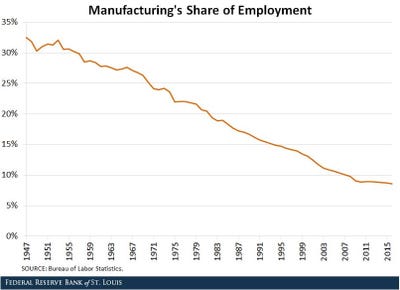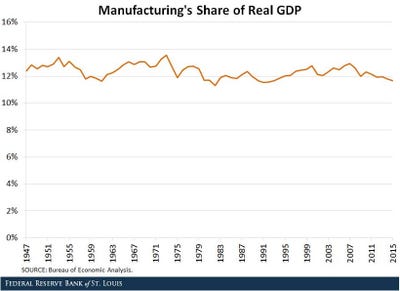Debunking Myths About US Manufacturing
Here are five myths about the decline in US manufacturing that are soundly busted.
September 21, 2023

Lukas Pankau is co-CEO of Industrial Next
There are several widely-held views about manufacturing, especially in the US, which don’t stand up to scrutiny. The sector has long been thought to be dying, but reports of the “death” of US manufacturing have been greatly exaggerated. Rather, the industry will play a pivotal role in the 21st-century economy.
Myth 1: Manufacturing is a Dying Industry
While it is true that the share of jobs in manufacturing has declined steadily in the US, this trend did not start in the 70’s or 80’s, but rather just after WWII.

Though manufacturing’s share of nominal GDP has also declined, its share of real GDP has remained a near-constant 12 percent. This is hardly the doom and gloom scenario that manufacturing’s detractors would lead you to believe.

Myth 2: The US Isn’t Competitive Globally
Another long-standing myth is that the US just isn’t competitive, especially in terms of labor costs. This is the main reason manufacturing jobs are exported to lower-cost countries, like Mexico, China, or Vietnam. The widely-held belief that US manufacturing has been effectively outsourced abroad is used as “supporting evidence” for its decline. Although there is some truth to this, the reality is more complicated. While much low-value manufacturing has departed the US shores and is unlikely to return, high value-add manufacturing has actually increased in recent years.
In fact, the US is often ranked at the top in global competitiveness, according to the World Economic Forum and the UN’s Competitive Industrial Performance Index. If the numbers don’t support this myth, why is it so persistent? It is due, in part, to average manufacturing wages in the US and other advanced economies being significantly higher than in lower-income countries. However, comparing those wages, real or nominal, is not comparing like-for-like and is misleading, considering manufacturing’s share of nominal GDP. The reason is that the US has lost the bulk of its manufacturing jobs not to other countries, but to automation.
The skills required to work effectively in high-value manufacturing are not the same as the skills in places like Asia, where manual labor – not automation – is the norm for the vast majority of manufacturing facilities. KPMG has considered the “all-in” costs of doing business in various countries, and the US ranks very favorably when considering this more detailed metric.
The KPMG report concludes that “for manufacturing activities that are more routine in nature and require less advanced skills, where the loss of productivity may be outweighed by lower costs, companies may consider locating their manufacturing facilities in lower costs countries such as China, Vietnam or Taiwan; however, in higher-value-added manufacturing where the process is more complex or automated and requires highly skilled labor to manage, the United States may be considered more favorably as a location.”
Despite the relatively high levels of automation and complexity present across its industries, the US still has a long way to go in its automation journey. Estimates vary, but only around 10 to 20 percent of all manufacturing processes are currently automated, with most of those in the automotive and electronics sectors.
McKinsey estimates that well over 80 percent of procedures currently being done manually are still ripe for automating. If the US is to remain competitive, more investments must be made in autonomous, intelligent, and modular automation.
Myth 3: Sunk Costs Are Too High
Many manufacturers are unwilling to make such investments, in large part because they have been burned by the marketing of “autonomous” manufacturing for many years, where the promise did not live up to the hype.
Every factory has a back room where the former “latest and greatest” automation technology is gathering dust. However much this causes reluctance to purchase newer equipment, the US cannot be caught out because of Aesop’s famous “crying wolf” allegory. This time, there really is a wolf: advancements in sensor technology and AI. Failing to understand how this is the case will leave the US flat-footed competitively.
Myth 4: AI is just a Parlor Trick
While tools like ChatGPT wow lay audiences, experienced practitioners know that it takes a lot more to revolutionize manufacturing technology. Many have heard this hype before, and it is justified to be cynical after years of false starts. Generative AI creating art and text is a step forward, but the applicability of such algorithms is narrow and unsuitable for most manufacturing applications.
The most relevant revolution is in machine learning, and it is happening at an unprecedented pace. What was once “pie-in-the-sky” claims are quickly becoming business-as-usual. Anyone left doubting the potential impact is at risk of losing their competitive edge, as this trend will only accelerate.
Myth 5: Automation Will Replace Everyone
Automation does not work in a vacuum. Well-trained workers must oversee the complex interactions between modules in order to take full advantage of these new technologies. Workers want to learn and improve their skill set, as no one is motivated to do 3D tasks (dirty, dull, dangerous) in the 21st century.
Furthermore, there is a reciprocal effect at play: the more mundane the manufacturing tasks, the less engaged the employee. As a result, companies recognize the lack of motivation and start seeing their people as interchangeable cogs. This trend cannot continue.
It is more difficult and costly to repurpose outdated manufacturing equipment than it is to educate or retrain motivated employees. That is partly why McKinsey views up-skilling as a definitive force in the future of manufacturing and sees the share of manual labor dropping over 25 percent between 2016 and 2030.
No matter the level of automation, highly skilled personnel are required to ensure that all systems continue to run smoothly and optimally for every facility. Without continuing to invest in people and their training, companies risk being left behind in the race for talent.
The Bottom Line
Manufacturing must become more efficient, autonomous, and increasingly dependent on AI and machine learning. Only through the deployment of advanced automation technology will workers be unchained from mundane tasks and allowed to unleash their full potential.
Lukas Pankau is co-CEO of Industrial Next, a company creating autonomous manufacturing for car manufacturers and other producers.
You May Also Like


